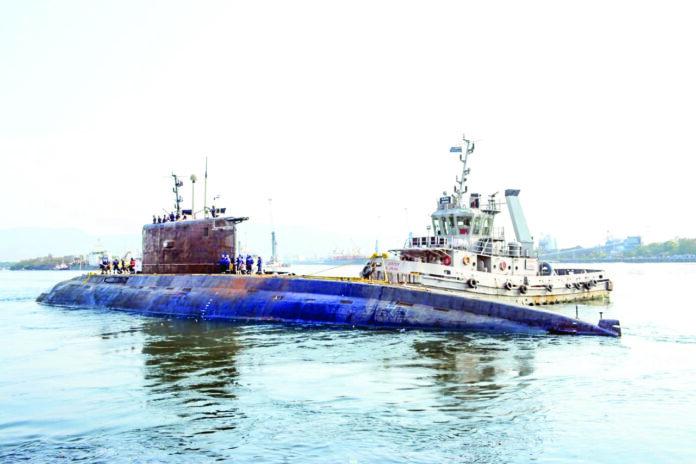NEW DELHI: Mazagon Dock Shipbuilders Limited (MDL) and Hindustan Shipyard Limited (HSL), India’s two premier defence shipyards, have inked a memorandum of understanding (MoU) in an attmept to speed up the country’s self-reliance efforts in submarine construction.
As part of the agreement, the Mumbai-based MDL and Visakhapatnam-headquartered HSL are to jointly carry out submarine projects, giving India submarine production capabilities that cover both the eastern and western coasts.
Why is this MoU important?
The recent strategic partnership between HSL and Mazagon Dock Shipbuilders Limited (MDL)—India’s traditional submarine builder—signifies an alignment designed to leverage both yards’ capabilities. HSL will contribute outfitting expertise, significantly reducing production timelines and optimising resource allocation across India’s submarine construction projects.
This dual-yard approach, combining the capabilities of MDL on the West Coast and HSL on the East Coast, offers significant strategic advantages. Historically, India’s reliance on a single construction facility has been seen as constraining submarine production capacity and timelines, making it challenging to meet the Navy’s strategic requirement of approximately two dozen submarines.
With two dedicated submarine-building yards now operational, India can efficiently achieve these critical force-level targets, overcome historical capacity limitations, and maintain sustained operational readiness and strategic flexibility.
While MDL has been an established player in the field of submarine reconstruction, HSL has rapidly built its capabilities to become a strong entrant into the field.
But how did HSL rise to this occasion?
THE ROLE OF HSL
HSL has a crucial role in India’s maritime defence sector. Initially established for naval ship repairs, HSL has steadily evolved, mastering the processes of submarine refits and upgrades. Now, it is ready to become a submarine-construction shipyard, critical to India’s ambitious defence strategy of achieving maritime self-reliance.
HSL waded into submarine expertise in the early 1970s, with the docking and repair of two Egyptian submarines, S-22 and S-23, in 1972. This achievement laid the foundational expertise for subsequent, increasingly advanced projects. By 1997, HSL had successfully expanded its capabilities to handle refits of India’s ageing Foxtrot-class submarines. In a short span of time, the public sector undertaking (PSU) was able to raise its profile manifold in the domestic naval community.
Then came the real turning point: the shipyard began working on complex projects involving Russian-origin EKM-class submarines. The experience gained from these undertakings was invaluable. It became a crucial stepping-stone, allowing HSL to start navigating the demanding technical challenges associated with modern submarine technologies. Each success in these projects contributed to positioning the company among India’s foremost maritime defence enterprises.
This image was solidified a decade ago, in 2015, when HSL achieved a landmark feat: the completion of a comprehensive mid-life upgrade for INS Sindhukirti. This remains India’s only successful mid-life submarine upgrade conducted domestically. The extensive overhaul required years of expertise and precision engineering.
The PSU shipyard had signalled to the country its readiness for even more ambitious submarine projects.
Building on that success, in 2020, HSL again demonstrated its efficiency and reliability by completing a routine refit of INS Sindhuvir well ahead of schedule. Such achievements highlighted the shipyard’s growing capability and emphasised its readiness to transition from refits and upgrades to full-scale submarine construction.
Currently, the ongoing Normal Refit of INS Sindhukirti has successfully completed two surface sorties and is now gearing up for full-power sea trials. The continued operational success has been key to maintaining stakeholders’ confidence in HSL’s competence.
Behind its achievements is of course HSL’s extensive infrastructure. Its facilities include specialised workshops for electrical and weapons systems, chemical cleaning bays, advanced pipe-fitting shops, and, notably, a deep-water waterfront capable of accommodating complex submarine operations. The depth of technical infrastructure HSL maintains remains unmatched by other Indian shipyards, positioning it ideally for the nation’s ambitious submarine construction programmes, like P75(I) and P76.
Connected to the shipyard’s physical infrastructure is a strategic local ecosystem: a skilled workforce, a trusted vendor base, and robust logistical networks. This local synergy significantly enhances the shipyard’s readiness to scale rapidly from submarine refits to comprehensive submarine construction.
ROLE OF GOVERNMENT
With its administrative transfer to the Ministry of Defence in 2010, the Indian government has increasingly recognised HSL’s strategic potential. Importantly, this strategic direction has historical roots, aligning clearly with a Cabinet Committee on Security (CCS) decision from 1999, which mandated the development of an alternate submarine construction facility on India’s East Coast.
This vision was reaffirmed and formalised in July 2010 when the Defence Acquisition Council (DAC) officially approved HSL as a facility for constructing conventional submarines, strategically diversifying India’s submarine-building capabilities.
Recent operations such as Operation Sindoor further highlight the strategic necessity of an effective submarine fleet. While this tri-service operation primarily involved long-range air and missile strikes, the maritime dynamics, particularly the support and movement of naval assets by countries friendly to Pakistan in the Arabian Sea and Bay of Bengal, highlight submarines’ critical role in maritime surveillance, deterrence, and wartime operational readiness. A robust submarine fleet remains essential for fulfilling the Indian Navy’s Blue Water ambitions and safeguarding national interests across the vast Indian Ocean region.
* Aritra Banerjee is a defence and security analyst.








